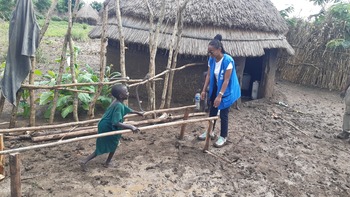share

Gatluak Muon uses parallel bars from HI to practice his rehabilitation exercises, Gambella, Ethiopia. | © HI
Gatluak Muon struggled with daily activities and felt isolated from his community. Thanks to physical rehabilitation with HI, he is already seeing progress.
Gatluak Muon is a seven-year-old boy living in the Nguenyyiel refugee camp of Gambella, Ethiopia. He was originally born in South Sudan, but warfare forced his family to flee to Ethiopia when he was only three years old.
When she was pregnant with him, Gatluak’s Muon’s mother did not have access to the medical follow-up she needed, which led to pregnancy complications and developmental delay in her baby. He was born with cerebral palsy, and experienced intellectual and physical disabilities by the time he was a year old. Movement and speaking became very difficult and he did not play with other children his age.
Gatluak Muon began to show signs of depression due to a lack of attention and support from his family and community. His appearance changed dramatically as he became thin and lost his strength. He experienced pain throughout his body and developed paralysis and muscle spasms, making it difficult to perform simple actions on his own.
One day, HI met Gatluak Muon when conducting door- to-door visits with its community workers and physical therapist. Gatluak Muon will always have cerebral palsy, but HI’s physical therapist noted that physical rehabilitation could improve his ability to perform everyday activities. After an individual assessment, the physical therapist developed a treatment plan that included various rehabilitation exercises, and they began working together right away.
to-door visits with its community workers and physical therapist. Gatluak Muon will always have cerebral palsy, but HI’s physical therapist noted that physical rehabilitation could improve his ability to perform everyday activities. After an individual assessment, the physical therapist developed a treatment plan that included various rehabilitation exercises, and they began working together right away.
At first, it was particularly challenging, since the exercises were sometimes painful. Gatluak Muon worked through the pain and continued performing exercises to improve his range of motion, stretching, and gait trainings. He regularly visited HI’s physical therapist, and was taught to practice his exercises twice a day. At home, he used parallel bars that HI made for him using locally-sourced materials. Gradually, he began to show progress, and after only a few weeks he could walk and stand with minimum assistance.
Gatluak Muon’s mother also played a significant role in his improvement. She learned the rehabilitation exercises with him and helped him practice at home every day. The intervention improved the mother-child bond between them and supported Gatluak Muon’s psychosocial wellbeing as well.
Today, the smile on his face says a lot. He is now playful, open and positively responding to the rehabilitation sessions that help make him more independent.
“I’m so happy with my child's improvement,” his mother says. “I hope he will be able to go to school and play with his friends soon.”








HI is an independent and impartial aid organisation working in situations of poverty and exclusion, conflict and disaster. We work alongside people with disabilities and vulnerable populations, taking action and bearing witness in order to respond to their essential needs, improve their living conditions and promote respect for their dignity and fundamental rights.
HI is an independent and impartial aid organisation working in situations of poverty and exclusion, conflict and disaster. We work alongside people with disabilities and vulnerable populations, taking action and bearing witness in order to respond to their essential needs, improve their living conditions and promote respect for their dignity and fundamental rights.